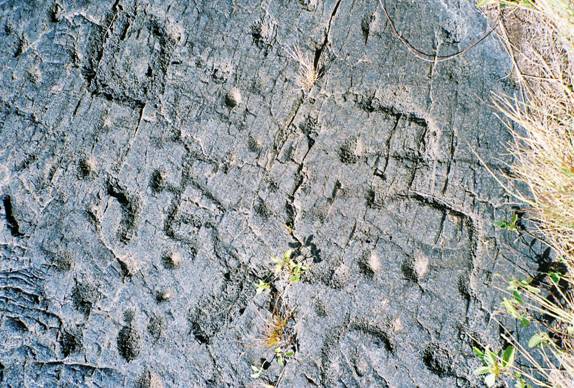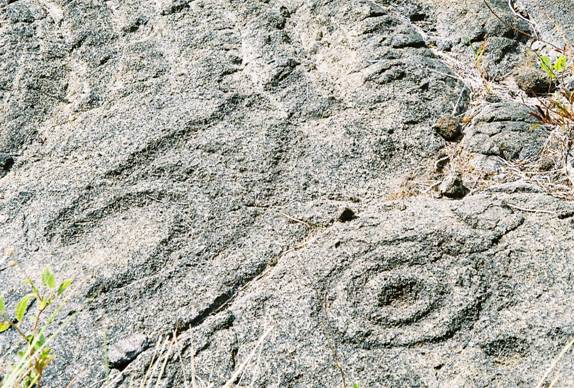Petroglyphs
of the Island of Hawai'i
by Carol Hallas
|
Students of petroglyphs always find it fascinating to study and compare the petroglyphs of various peoples around the world. Since very little is actually known about worldwide petroglyphs it is interesting to consider the information available about the petroglyphs of other cultures. Since earliest times peoples have used petroglyphs to teach, to commemorate events, and to preserve information and pass it along to future generations. Hawaiians were no exception. The Hawaiian Island chain is more than fifteen hundred miles long, continuing past Midway Island of WWII fame to Kure Atoll, the most northwesterly point. In the Hawaiian Island chain petroglyphs have been found on all the major islands but it has only been in the last 30 years or so that research has been expanded and these cultural artifacts have been seriously studied. Some are buried in the sand or obscured to various degrees by the sea. Some are in places that are difficult to access such as on the sides of cliffs. But, by far, the largest number exist on Hawaii, the "Big Island". These are also the easiest to find and observe. The largest field of petroglyphs can be found at Pu'uloa (long hill) near the southeastern shore of the Big Island. The number and range of figures is enormous, but unfortunately, this huge petroglyph field is on the flanks of Kilauea, the world's most active volcano. At each new major eruption (it has been erupting continuously since 1983) there is always fear that more and more of the petroglyphs will be lost.
Certainly the most numerous rock markings at Pu'uloa are the cupules, seen in the photo above. The cupules are believed to be where baby umbilical cords were placed to ensure a long life, the figurative meaning of Pu'uloa being "long life". A similar petroglyph often seen has a cupule with 1 or more rings around it. You can see an example of this on the right side of the following photo:
Some believe that these are also for umbilical cords, but a different meaning was attributed in 1823 by William Ellis. Ellis was the surgeon's second mate on Captain Cook's third voyage. He wrote a book about his travels in Hawaii, among other islands, which was published in 1833. In it he describes the meaning as follows: "When there were a number of concentric circles with a dot or mark in the center,, the dot signified a man, and the number of rings denoted the number in the party who had circumambulated the island. When there was a ring and a number of marks, it denoted the same; the number of marks showing of how many the party consisted; and the ring, that they had traveled completely round the island; but when there was only a semicircle, it denoted that they had returned after reaching the place where it was made." |
||
|
|
|
|
|
|
||
| History | Atlas | Culture | Language | Links |

